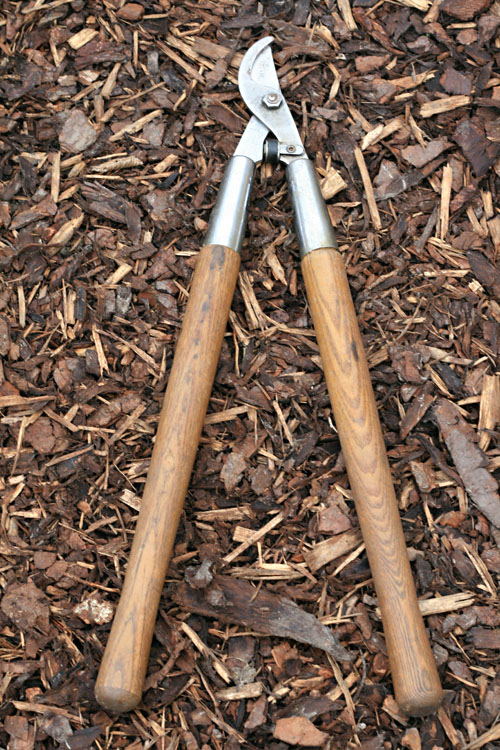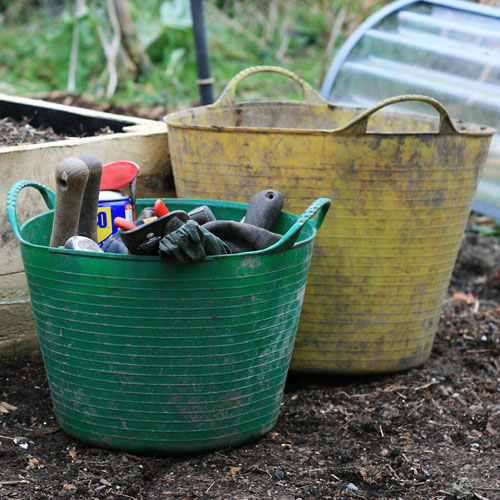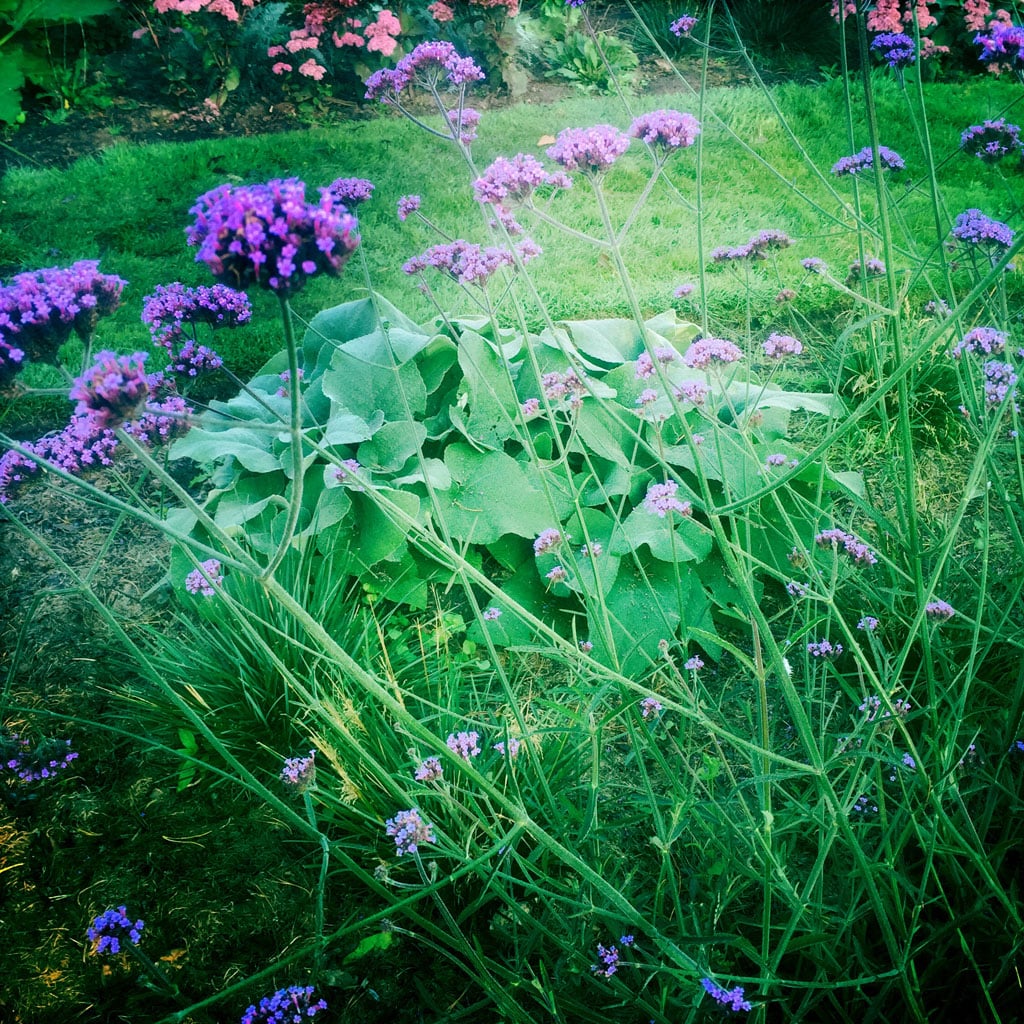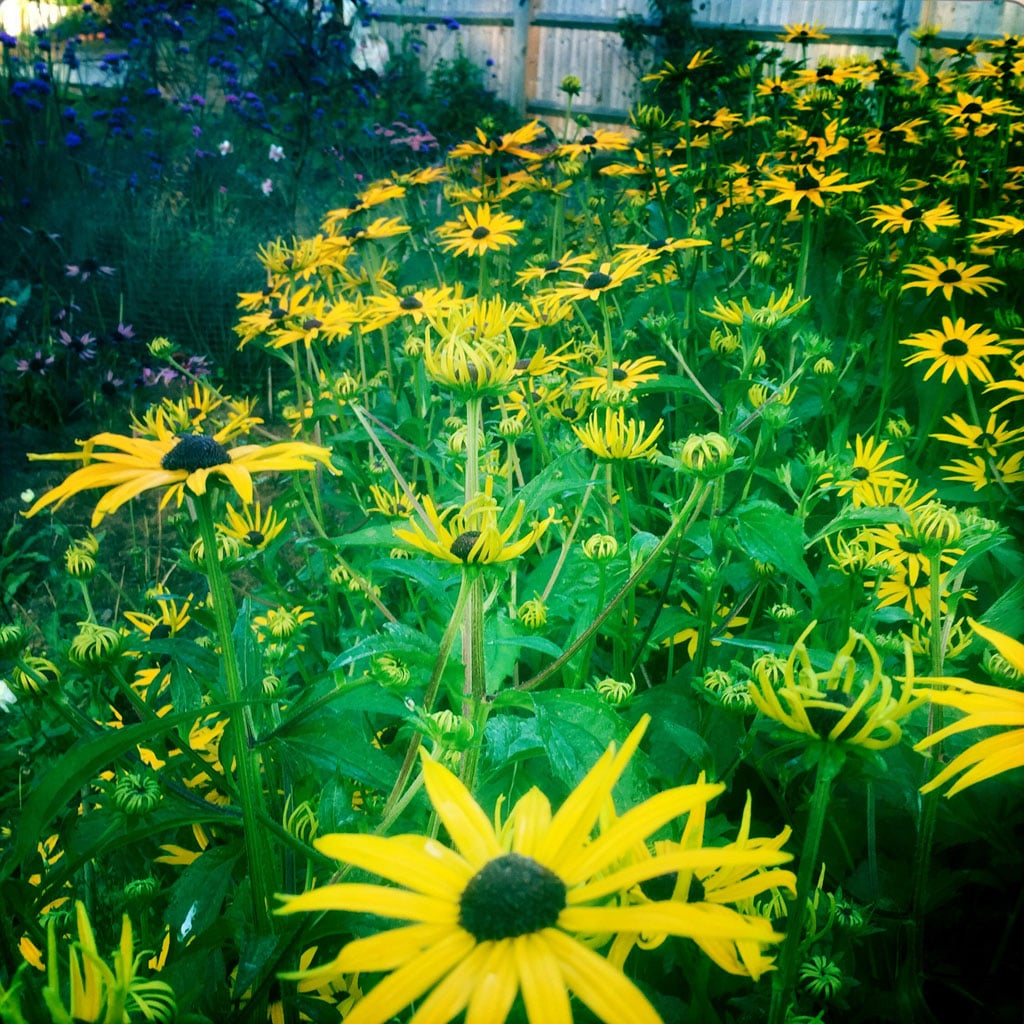The Chelsea Flower show opened its gates to RHS members today, before welcoming in the general public on Thursday. It’s a great opportunity to see the work of some of the most talented garden designers, immerse yourself in a fabulous variety of plants, and pick the brains of the most expert nursery folk in the country, if not the world. Naturally, I left it too late to buy a ticket. Fortunately for me, this year I’ve been in the extraordinarily privileged position of being involved with with the preparations for not one, but two multi award-winning nurseries, Hardy’s Cottage Garden Plants (and Rosemary Hardy’s first show garden) and Fibrex Nurseries, which allowed me access to the site during the build. Having spent another wonderful day surrounded by pelargoniums, laughter and more tea than my bladder could reasonably be expected to contain, I left the Fibrex stand in the Great Pavillion at around six on Sunday evening and headed off to make a round of the show gardens.
Preparing Fibrex Nurseries’ pelargonium display for another Cheslea gold
While you can expect me to be a little biased about the garden I worked on (a post on the background to Rosy’s Forever Freefolk garden here, and, likely as not, more to come), I’ll whisk you through some of my favourite sights, as captured on camera in the failing evening light of the final hours before press day.
Detail from Rosy Hardy’s Forever Freefolk garden for Brewin Dolphin, RHS Chelsea Flower Show 2016
The Chelsea Barracks Garden by Jo Thompson. A streamlined curving rill runs through grey stone, representing the lost river Westbourne that flows beneath the site of the Chelsea Barracks. This is a modern rose garden, referencing the rose window of the listed Garrison chapel that will be preserved as a focal point in the new development now owned by the Qatari royal family.
Detail from Jo Thompson’s Chelsea Barracks Garden for Qatari Diar, RHS Chelsea Flower Show 2016
Detail from Jo Thompson’s Chelsea Barracks Garden for Qatari Diar, RHS Chelsea Flower Show 2016
Detail from Jo Thompson’s Chelsea Barracks Garden for Qatari Diar, RHS Chelsea Flower Show 2016
The garden blends roses with perennials and biennials, offset by the bronze hued metal of the sleek, sweeping bench seats and the upright pillars which intersect the tall yew hedging. It’s a masterly blend of sleek, contemporary lines and finishes with a very traditional, cottage-garden style planting.
Detail from Jo Thompson’s Chelsea Barracks Garden for Qatari Diar, RHS Chelsea Flower Show 2016
Detail from Jo Thompson’s Chelsea Barracks Garden for Qatari Diar, RHS Chelsea Flower Show 2016
Detail from Jo Thompson’s Chelsea Barracks Garden for Qatari Diar, RHS Chelsea Flower Show 2016
Controversially, this garden features a lawn – a wonderful, circular bowling green-flat stretch of turf*. There’s a lot of rot talked about lawns, and although I don’t hold with chucking chemicals and valuable water at them, while our climate will sustain such useful, restful patches of green space, I’m happy to allow them room in the garden, and pleased to see the odd example at Chelsea. This won a gold medal for Jo and sponsors Qatari Diar, and deservedly so. Well done, judges.
Detail from Jo Thompson’s Chelsea Barracks Garden for Qatari Diar, RHS Chelsea Flower Show 2016
Cleve West has worked his magic again, this time with a garden inspired by Exmoor National Park where he spent his youth. Sunlight filters through the oak woodland canopy onto The M&G Garden, the dappled shade creating the perfect environment for epimediums, ferns and other perennials and grasses that work well on the woodland edge.
Detail from Cleve West’s M&G Garden, RHS Chelsea Flower Show 2016
The themes are memory, strength and longevity, but while Dan Pearson’s wonderful homage to Chatsworth at last year’s Chelsea almost conjured you into the Derbyshire countryside, this garden feels much more like a contemporary space inspired by memories of aspects of a specific place.
Detail from Cleve West’s M&G Garden, RHS Chelsea Flower Show 2016
Detail from Cleve West’s M&G Garden, RHS Chelsea Flower Show 2016
Detail from Cleve West’s M&G Garden, RHS Chelsea Flower Show 2016
Detail from Cleve West’s M&G Garden, RHS Chelsea Flower Show 2016
There’s a central sunken terrace, outward from which radiate stone and gravel paths that wind their way through the woodland glades, past substantial sandstone borders, some with rain-weathered hollows making a de facto bird bath here, a miniature reflecting pool there. It’s a tranquil, energising space, another worthy gold medal winner.
Detail from Cleve West’s M&G Garden, RHS Chelsea Flower Show 2016
Detail from Cleve West’s M&G Garden, RHS Chelsea Flower Show 2016
Andy Sturgeon’s garden for The Telegraph also uses monolithic structures, although here the slabs are of bronze-coated steel and arranged in a stylised manner which manages to suggest at once both the bony back plates of a stegosaurus, and a jagged mountain range thrust from the earth in some tumultuous seismic event. Both are intentional, the theme of the garden being the changes wrought upon our planet over geological time and scale.
Detail from Andy Sturgeon’s garden for The Telegraph, RHS Chelsea Flower Show 2016
It’s an awe-inspiring garden, which contrasts the drama of the sculptural elements and the purbeck limestone boulders (some containing fossils) strewn over the site, with a delicacy of touch evident in the semi-arid planting. This latter uses a restricted colour palette – mainly greens and blues with splashes of hotter orange (Digitalis canariensis) and red (the Australian kangaroo paw, Anigozanthus).
Detail from Andy Sturgeon’s garden for The Telegraph, RHS Chelsea Flower Show 2016
Detail from Andy Sturgeon’s garden for The Telegraph, RHS Chelsea Flower Show 2016
The upper story is dominated by a holm oak Quercus ilex, a strawberry tree Arbutus unedo, and the frothy foliage of Schinus molle, the Peruvian pepper tree.
Detail from Andy Sturgeon’s garden for The Telegraph, RHS Chelsea Flower Show 2016
A bridge of smooth limestone crosses the gorge filled with “meltwater”, going some way to inject a touch of domestication to the wildness, but this is still a very dramatic place. I loved the planting, the theatre, and the execution. This year’s Best in Show.
Detail from Andy Sturgeon’s garden for The Telegraph, RHS Chelsea Flower Show 2016
Charlie Albone’s garden for Husqvarna garnered silver gilt for its marriage of lush, European formality with Antipodean colour. Clipped yew hedges, squared pleached hornbeams and stepped box surround a sunken square lawn, through which a path of grey stones travells up and down the levels to a suspended seating area at the rear. A rill rounds the path and lawn, contained within the same bronze/corten steel coloured material that is a feature in so many of the gardens this year. It’s lush, and disciplined, but the perennials in the border in shades of cream, purple and mauve inject an element of chaotic fun, without getting too unruly. More digitalis, also eremurus giving the tall vertical accents in the beds, while alliums and poppies gently jostle with leucadendron and grevillea in a kind of floral equivalent of the Ashes.
Detail from Charlie Albone’s Husqvarna Garden, RHS Chelsea Flower Show 2016
Detail from Charlie Albone’s Husqvarna Garden, RHS Chelsea Flower Show 2016
Detail from Charlie Albone’s Husqvarna Garden, RHS Chelsea Flower Show 2016
Detail from Charlie Albone’s Husqvarna Garden, RHS Chelsea Flower Show 2016
The Winton Beauty of Mathematics Garden by Nick Bailey of Chelsea Physic Garden is a celebration of the laws of logic and maths that underpin life, and are seen to be at work in the natural world. A copper band winds through the garden, etched with mathematical equations. At one point it's a bench, then it becomes a stair rail, then a balustrade atop the roof of the garden structure, overhung with trailing plants. Architctural forms of Aloe polyphylla, Aeonium tabuliforme and yuccas feature prominently, while Pinus sylvestris ‘Watereri’ and Banksia integrifolia lend height to the planting. It's an inspiring, immersive space, with layer upon layer of detail, which importantly (to me, at least) works well as a beautiful garden.
Detail from Nick Bailey’s Winton Beauty of Mathematics Garden, RHS Chelsea Flower Show 2016
Detail from Nick Bailey’s Winton Beauty of Mathematics Garden, RHS Chelsea Flower Show 2016
Detail from Nick Bailey’s Winton Beauty of Mathematics Garden, RHS Chelsea Flower Show 2016
James Basson is back with another masterful evocation of the Provencal landscape for L’Occitane. More lavender, rocky terroir and stunted almond trees. You can almost feel the heat baking the stones underfoot – another gold medal for this skillful recreation of a unique landscape.
Detail from James Basson’s L’Occitane Garden, RHS Chelsea Flower Show 2016
Detail from James Basson’s L’Occitane Garden, RHS Chelsea Flower Show 2016
I spent several moments during the build admiring the pear stepovers on Jekka McVicar’s Modern Apothecary Garden for St John's Hospice. This is a healing space, with a circular path of pebbles surrounding a thyme and chamomile lawn, in the centre of which stands a water feature. Two benches nestle among the outer beds, packed with medicinal herbs and aromatics, the whole garden bordered by a herbal ley, which is how I shall from this point on be referring to my weed-ridden lawn.
Detail from Jekka McVicar’s Modern Apothecary Garden for St John’s Hospice RHS Chelsea Flower Show 2016
Detail from Jekka McVicar’s Modern Apothecary Garden for St John’s Hospice RHS Chelsea Flower Show 2016
It’s the kind of intensive, herb-stuffed space I’ve always wanted to grow myself, and not yet managed – most of my herbs living in pots out of reach of the more antisocial activities of Bill the border terrier. I often wonder what kind of havoc he’d cause if let loose at Chelsea.
Detail from Jekka McVicar’s Modern Apothecary Garden for St John’s Hospice RHS Chelsea Flower Show 2016
Detail from Jekka McVicar’s Modern Apothecary Garden for St John’s Hospice RHS Chelsea Flower Show 2016
The light began to fade, and my camera’s meter started to behave oddly, notwithstanding the fact I’d had rather a long day. Just time for a shot of Matthew Wilson’s Garden for Yorkshire, inspired by the East Window of York Minster, in which the perennial planting cleverly echoes the panes of the stained glass.
Detail from Matthew Wilson’s Garden for Yorkshire, RHS Chelsea Flower Show 2016
Something of a whirlwind trip around the show gardens, but a fantastic opportunity to see them without the crowds, as well as having been on site to witness their progress from soggy patches of muddy ground to fully realised designs. Chelsea 2016 is certainly not one RHS show I’ll be forgetting in a hurry.
* I saw this being cut to shape by a friendly chap, Roger Moore, of Lindum Turf in Yorkshire. I was laughing at him edging the turf with a battery operated angle grinder with cutting wheel attached, when he pointed out that the grass seed sown into and grown on a felt, rather than soil-based substrate. Perfect for show gardens and exhibition stands. Lindum also provide wildflower turf for meadows and green roofs.



































































































































